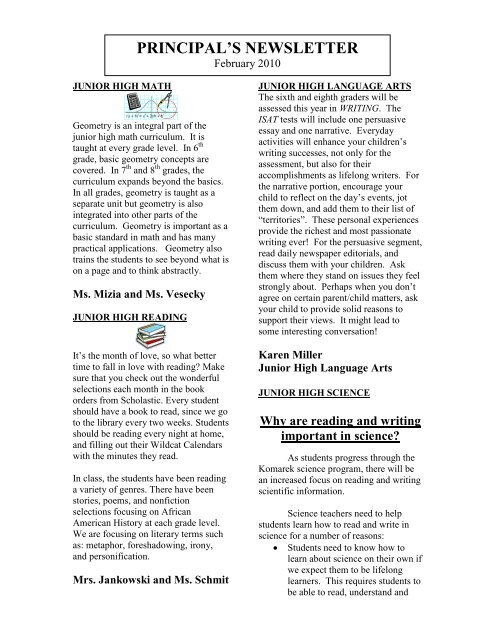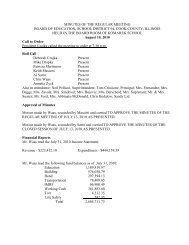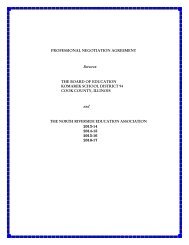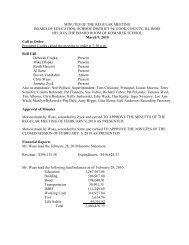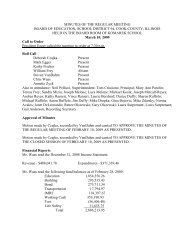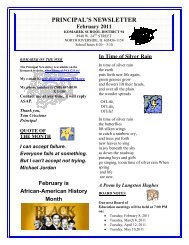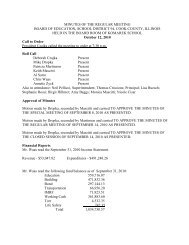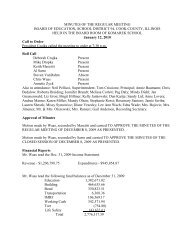Feb_ 10 - Komarek School District 94
Feb_ 10 - Komarek School District 94
Feb_ 10 - Komarek School District 94
Create successful ePaper yourself
Turn your PDF publications into a flip-book with our unique Google optimized e-Paper software.
JUNIOR HIGH MATH<br />
PRINCIPAL’S NEWSLETTER<br />
<strong>Feb</strong>ruary 20<strong>10</strong><br />
Geometry is an integral part of the<br />
junior high math curriculum. It is<br />
taught at every grade level. In 6 th<br />
grade, basic geometry concepts are<br />
covered. In 7 th and 8 th grades, the<br />
curriculum expands beyond the basics.<br />
In all grades, geometry is taught as a<br />
separate unit but geometry is also<br />
integrated into other parts of the<br />
curriculum. Geometry is important as a<br />
basic standard in math and has many<br />
practical applications. Geometry also<br />
trains the students to see beyond what is<br />
on a page and to think abstractly.<br />
Ms. Mizia and Ms. Vesecky<br />
JUNIOR HIGH READING<br />
It’s the month of love, so what better<br />
time to fall in love with reading? Make<br />
sure that you check out the wonderful<br />
selections each month in the book<br />
orders from Scholastic. Every student<br />
should have a book to read, since we go<br />
to the library every two weeks. Students<br />
should be reading every night at home,<br />
and filling out their Wildcat Calendars<br />
with the minutes they read.<br />
In class, the students have been reading<br />
a variety of genres. There have been<br />
stories, poems, and nonfiction<br />
selections focusing on African<br />
American History at each grade level.<br />
We are focusing on literary terms such<br />
as: metaphor, foreshadowing, irony,<br />
and personification.<br />
Mrs. Jankowski and Ms. Schmit<br />
JUNIOR HIGH LANGUAGE ARTS<br />
The sixth and eighth graders will be<br />
assessed this year in WRITING. The<br />
ISAT tests will include one persuasive<br />
essay and one narrative. Everyday<br />
activities will enhance your children’s<br />
writing successes, not only for the<br />
assessment, but also for their<br />
accomplishments as lifelong writers. For<br />
the narrative portion, encourage your<br />
child to reflect on the day’s events, jot<br />
them down, and add them to their list of<br />
“territories”. These personal experiences<br />
provide the richest and most passionate<br />
writing ever! For the persuasive segment,<br />
read daily newspaper editorials, and<br />
discuss them with your children. Ask<br />
them where they stand on issues they feel<br />
strongly about. Perhaps when you don’t<br />
agree on certain parent/child matters, ask<br />
your child to provide solid reasons to<br />
support their views. It might lead to<br />
some interesting conversation!<br />
Karen Miller<br />
Junior High Language Arts<br />
JUNIOR HIGH SCIENCE<br />
Why are reading and writing<br />
important in science?<br />
As students progress through the<br />
<strong>Komarek</strong> science program, there will be<br />
an increased focus on reading and writing<br />
scientific information.<br />
Science teachers need to help<br />
students learn how to read and write in<br />
science for a number of reasons:<br />
• Students need to know how to<br />
learn about science on their own if<br />
we expect them to be lifelong<br />
learners. This requires students to<br />
be able to read, understand and


